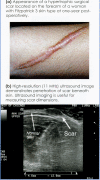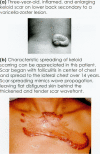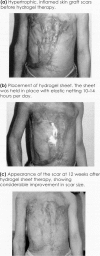Abstract
Today, wound management to avoid excessive scar formation is increasingly important, especially in populations with Fitzpatrick 3 or higher skin pigmentation. Medical science and industrial development are devoting more effort toward understanding and offering better therapy to control scars. However, advances in scar management have been hampered by the confusing or ambiguous terminology. There is no consensus on what amount of post-traumatic skin scar formation is "normal" and what should be considered "hypertrophic". In the World Health Organization's ICD-9, there is no diagnostic code for hypertrophic scar--only keloid is listed. Yet, the medical and scientific literature distinguishes them as different conditions. Our experience suggests that the diagnosis of keloid disease is greatly over-rendered. For black patients, an elevated scar seems, by default, diagnosed as keloid by most. This confusion results in inappropriate management of scar formation, and occasionally contributes to decision making related to elective or cosmetic surgery. Given that patients are expecting better outcomes from wound care today than in the past, this review article attempts to capture the essential biological factors related to wound scar production and discusses treatment options and indications used by the authors.
Full text
PDF
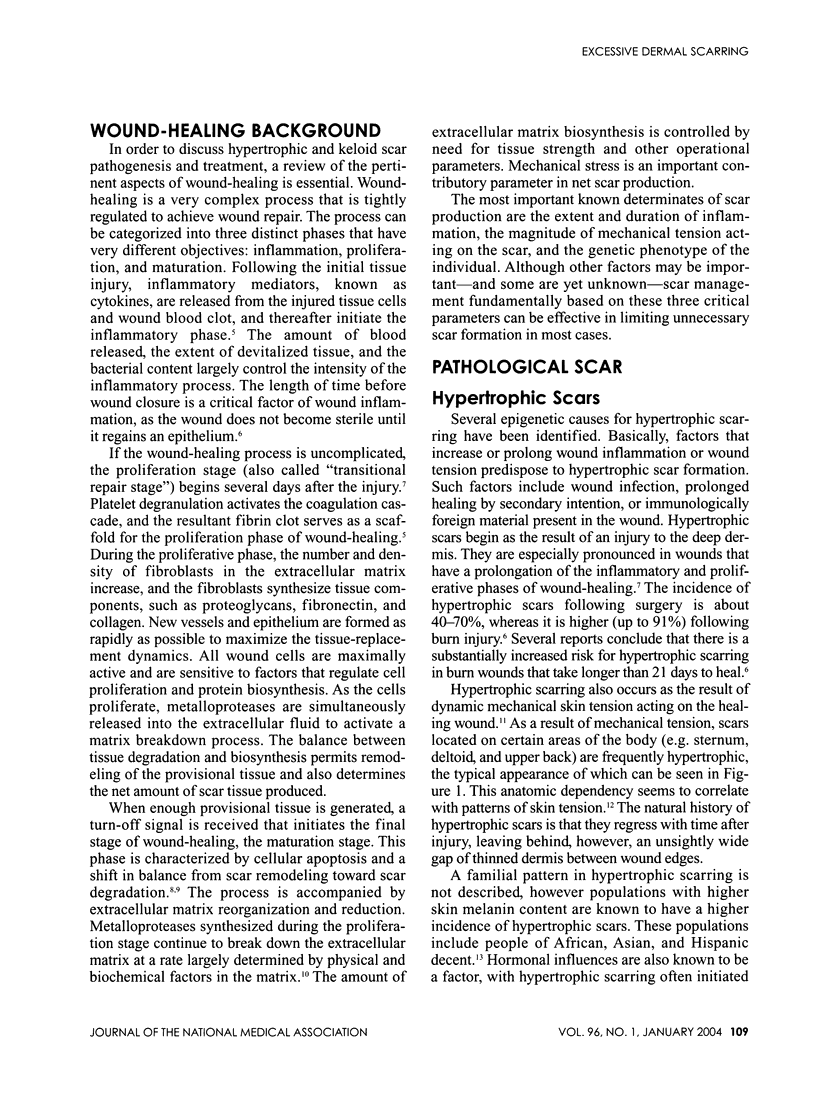
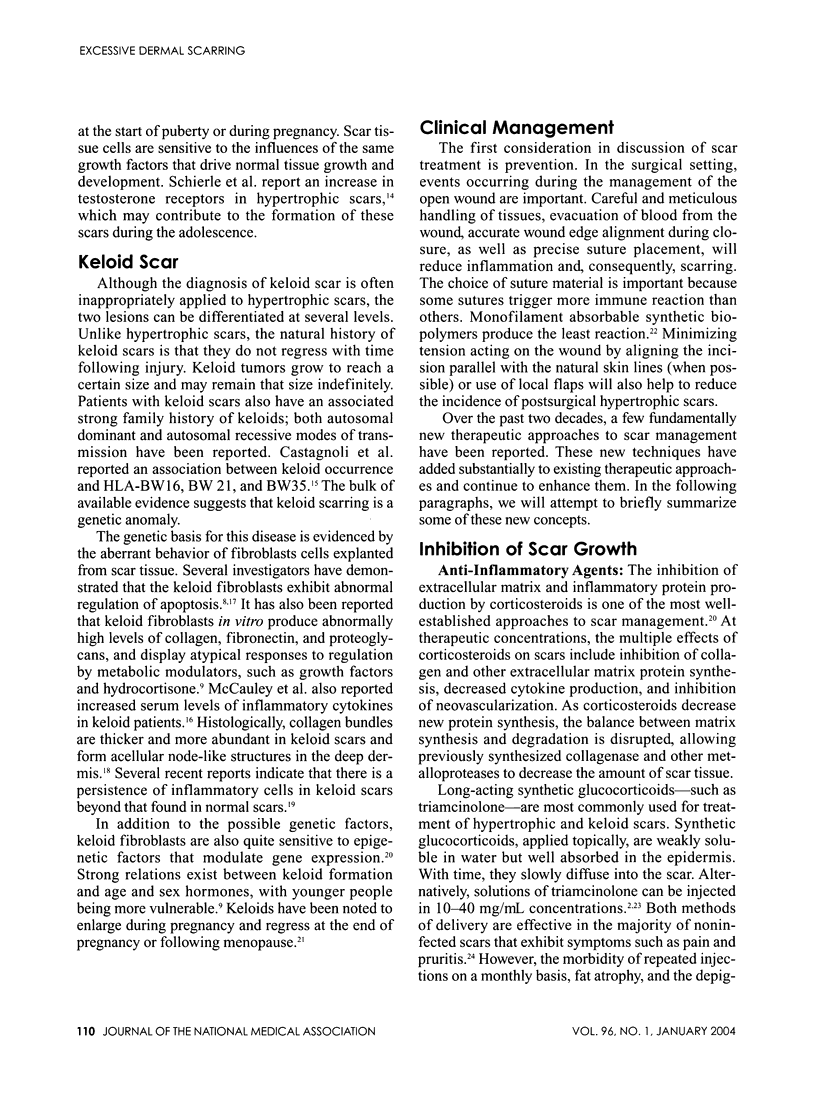
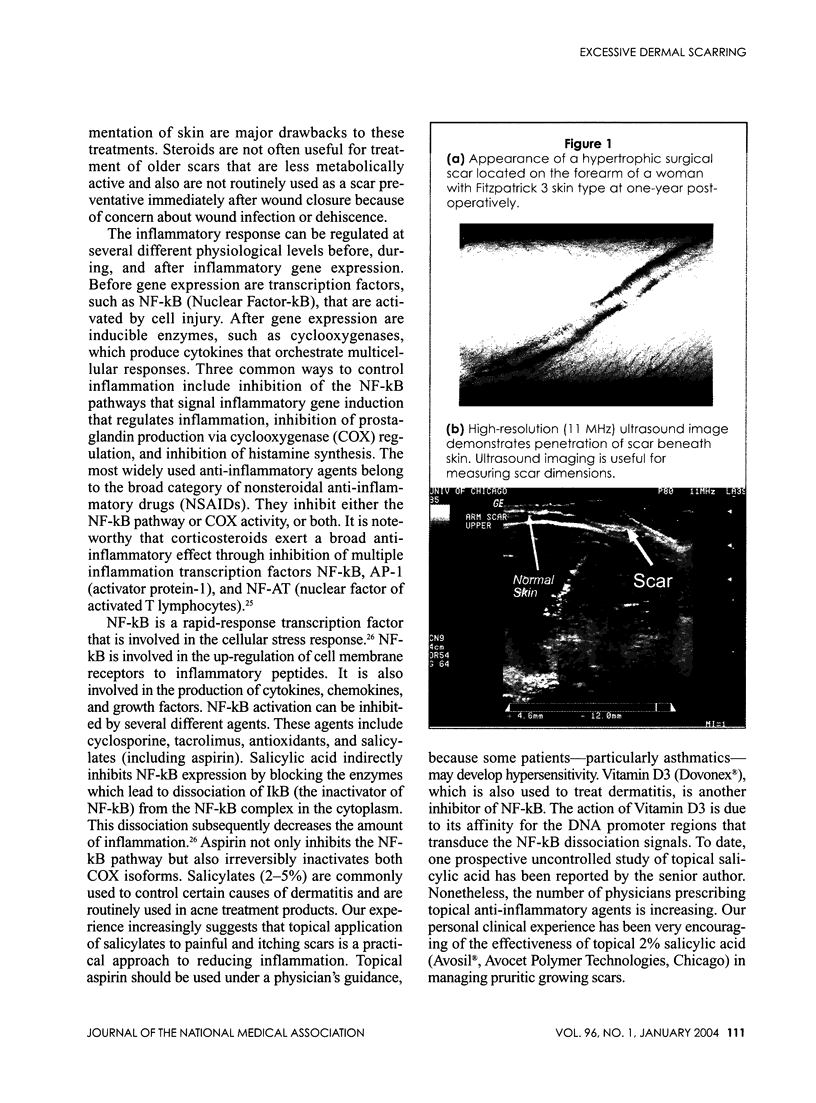
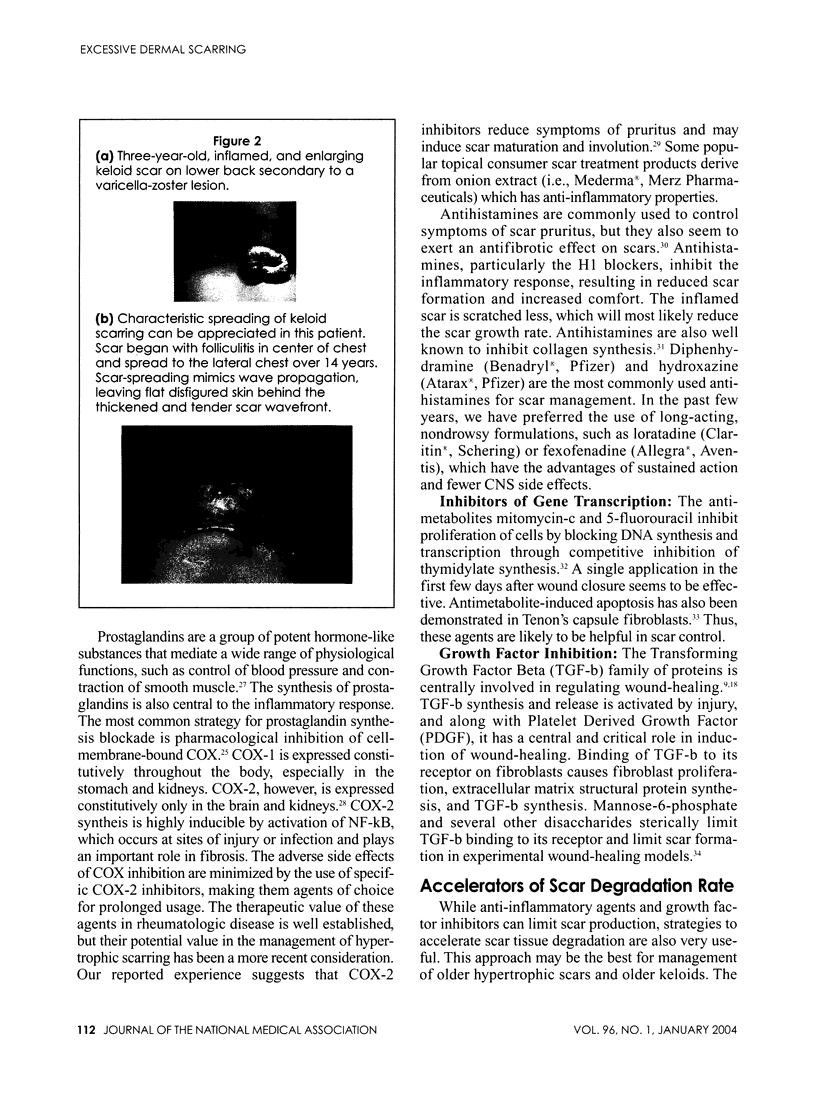
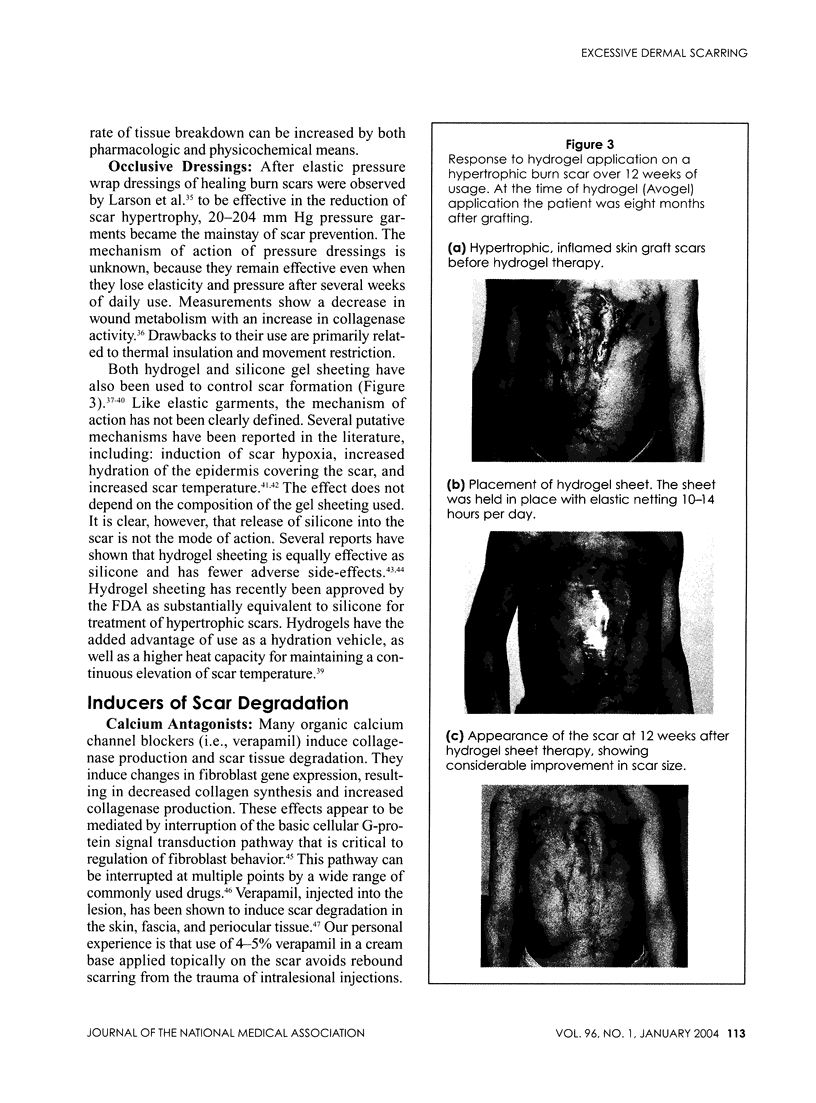
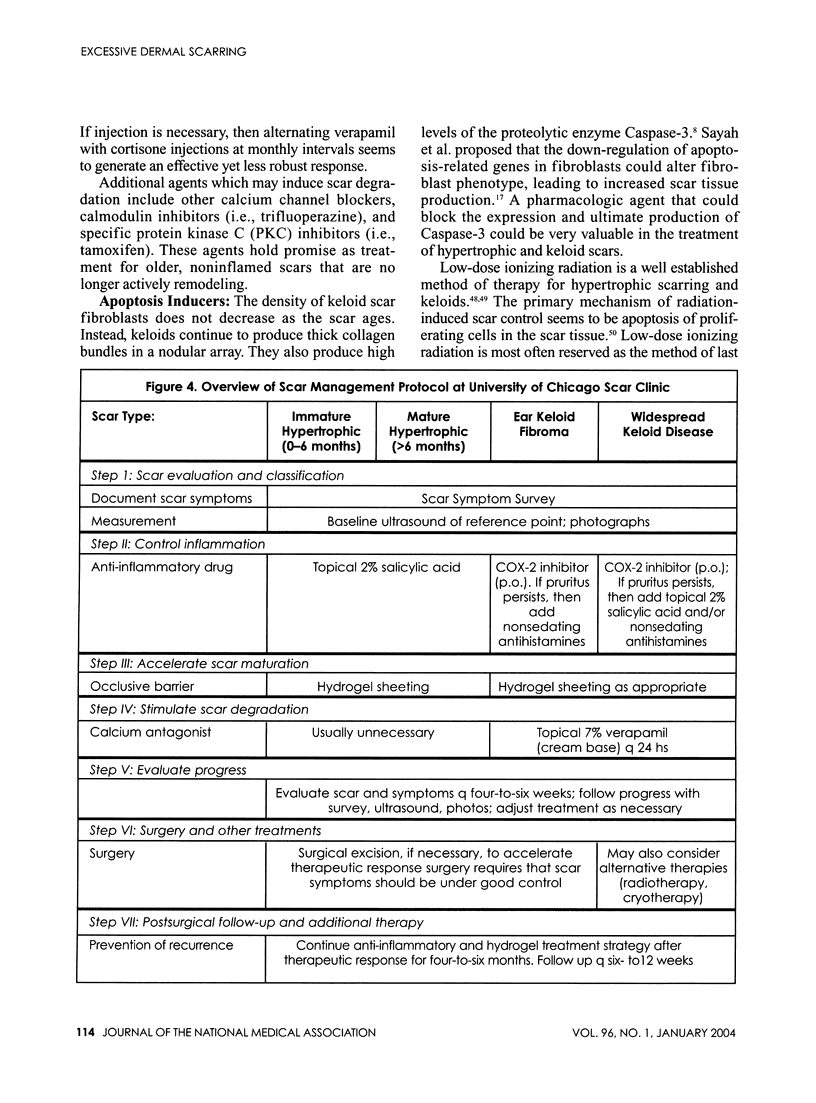
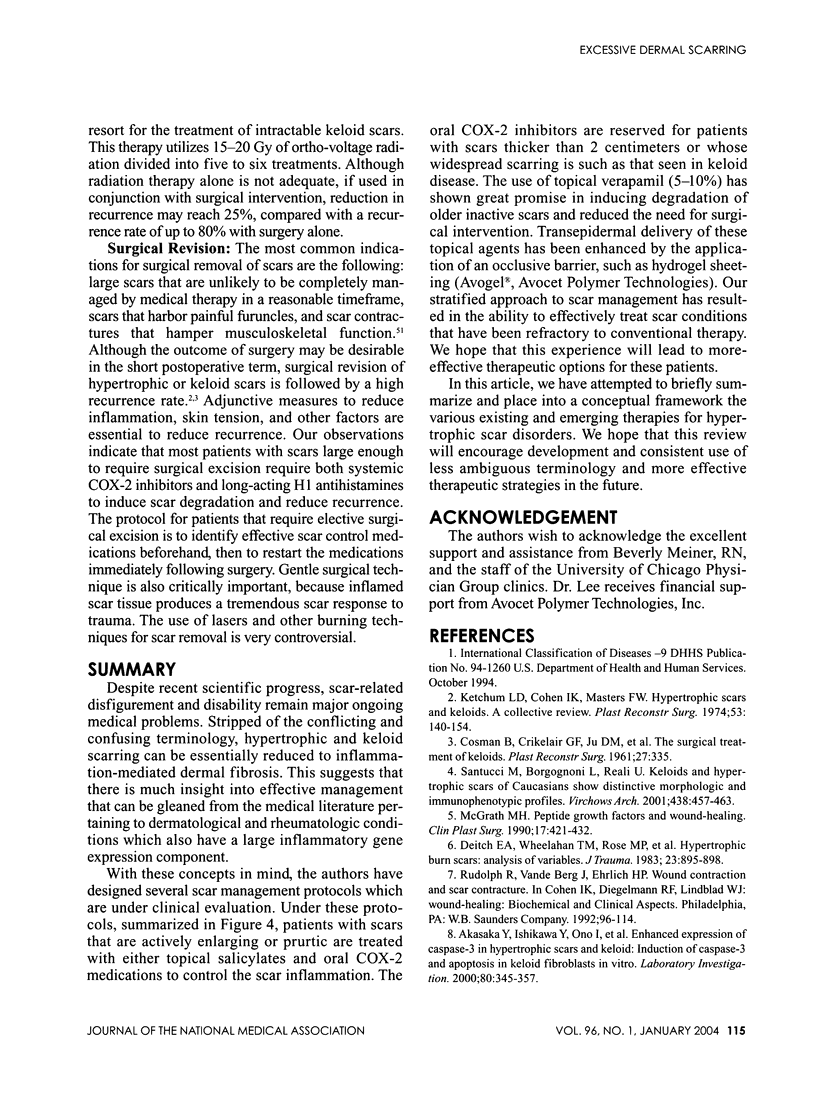
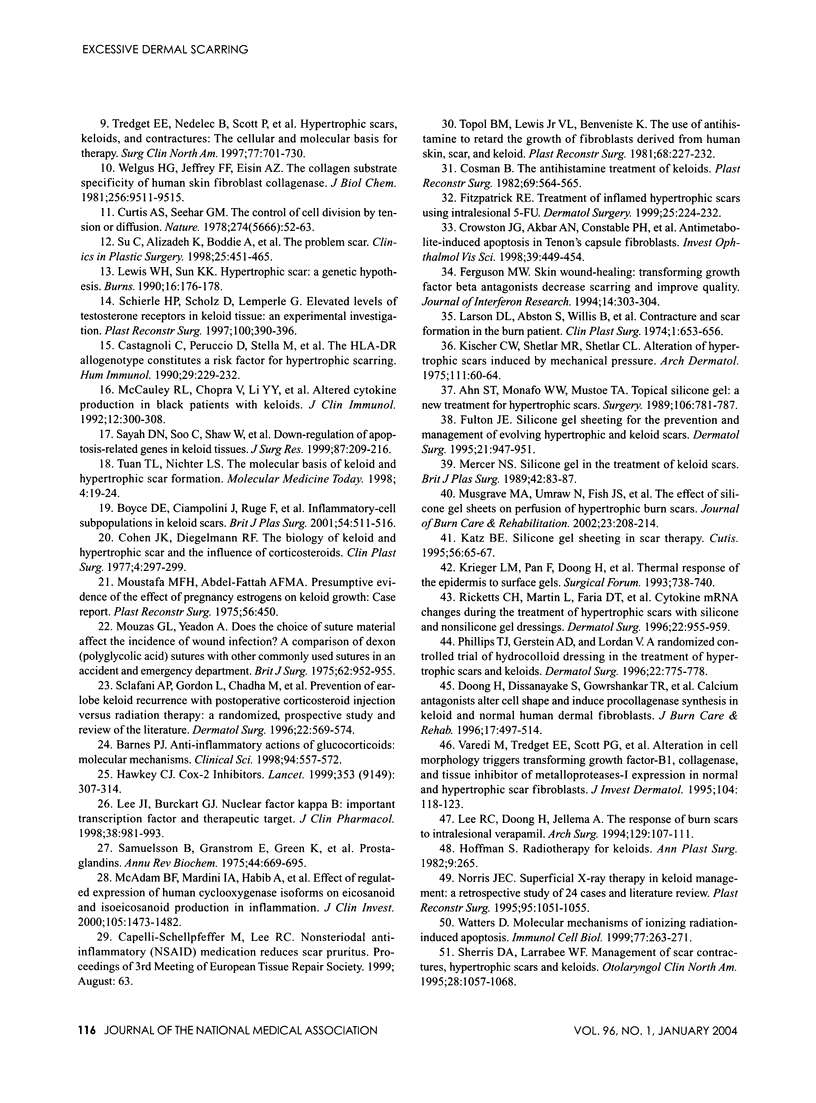
Images in this article
Selected References
These references are in PubMed. This may not be the complete list of references from this article.
- Ahn S. T., Monafo W. W., Mustoe T. A. Topical silicone gel: a new treatment for hypertrophic scars. Surgery. 1989 Oct;106(4):781–787. [PubMed] [Google Scholar]
- Akasaka Y., Ishikawa Y., Ono I., Fujita K., Masuda T., Asuwa N., Inuzuka K., Kiguchi H., Ishii T. Enhanced expression of caspase-3 in hypertrophic scars and keloid: induction of caspase-3 and apoptosis in keloid fibroblasts in vitro. Lab Invest. 2000 Mar;80(3):345–357. doi: 10.1038/labinvest.3780039. [DOI] [PubMed] [Google Scholar]
- Barnes P. J. Anti-inflammatory actions of glucocorticoids: molecular mechanisms. Clin Sci (Lond) 1998 Jun;94(6):557–572. doi: 10.1042/cs0940557. [DOI] [PubMed] [Google Scholar]
- Boyce D. E., Ciampolini J., Ruge F., Murison M. S., Harding K. G. Inflammatory-cell subpopulations in keloid scars. Br J Plast Surg. 2001 Sep;54(6):511–516. doi: 10.1054/bjps.2001.3638. [DOI] [PubMed] [Google Scholar]
- Castagnoli C., Peruccio D., Stella M., Magliacani G., Mazzola G., Amoroso A., Richiardi P. The HLA-DR beta 16 allogenotype constitutes a risk factor for hypertrophic scarring. Hum Immunol. 1990 Nov;29(3):229–232. doi: 10.1016/0198-8859(90)90117-8. [DOI] [PubMed] [Google Scholar]
- Cohen I. K., Diegelmann R. F. The biology of keloid and hypertrophic scar and the influence of corticosteroids. Clin Plast Surg. 1977 Apr;4(2):297–299. [PubMed] [Google Scholar]
- Cosman B. The antihistamine treatment of keloids. Plast Reconstr Surg. 1982 Mar;69(3):564–565. doi: 10.1097/00006534-198203000-00039. [DOI] [PubMed] [Google Scholar]
- Crowston J. G., Akbar A. N., Constable P. H., Occleston N. L., Daniels J. T., Khaw P. T. Antimetabolite-induced apoptosis in Tenon's capsule fibroblasts. Invest Ophthalmol Vis Sci. 1998 Feb;39(2):449–454. [PubMed] [Google Scholar]
- Curtis A. S., Seehar G. M. The control of cell division by tension or diffusion. Nature. 1978 Jul 6;274(5666):52–53. doi: 10.1038/274052a0. [DOI] [PubMed] [Google Scholar]
- Deitch E. A., Wheelahan T. M., Rose M. P., Clothier J., Cotter J. Hypertrophic burn scars: analysis of variables. J Trauma. 1983 Oct;23(10):895–898. [PubMed] [Google Scholar]
- Doong H., Dissanayake S., Gowrishankar T. R., LaBarbera M. C., Lee R. C. The 1996 Lindberg Award. Calcium antagonists alter cell shape and induce procollagenase synthesis in keloid and normal human dermal fibroblasts. J Burn Care Rehabil. 1996 Nov-Dec;17(6 Pt 1):497–514. [PubMed] [Google Scholar]
- Ferguson M. W. Skin wound healing: transforming growth factor beta antagonists decrease scarring and improve quality. J Interferon Res. 1994 Oct;14(5):303–304. doi: 10.1089/jir.1994.14.303. [DOI] [PubMed] [Google Scholar]
- Fitzpatrick R. E. Treatment of inflamed hypertrophic scars using intralesional 5-FU. Dermatol Surg. 1999 Mar;25(3):224–232. doi: 10.1046/j.1524-4725.1999.08165.x. [DOI] [PubMed] [Google Scholar]
- Fulton J. E., Jr Silicone gel sheeting for the prevention and management of evolving hypertrophic and keloid scars. Dermatol Surg. 1995 Nov;21(11):947–951. doi: 10.1111/j.1524-4725.1995.tb00531.x. [DOI] [PubMed] [Google Scholar]
- Hawkey C. J. COX-2 inhibitors. Lancet. 1999 Jan 23;353(9149):307–314. doi: 10.1016/s0140-6736(98)12154-2. [DOI] [PubMed] [Google Scholar]
- Hoffman S. Radiotherapy for keloids. Ann Plast Surg. 1982 Sep;9(3):265–265. doi: 10.1097/00000637-198209000-00020. [DOI] [PubMed] [Google Scholar]
- Katz B. E. Silicone gel sheeting in scar therapy. Cutis. 1995 Jul;56(1):65–67. [PubMed] [Google Scholar]
- Ketchum L. D., Cohen I. K., Masters F. W. Hypertrophic scars and keloids. A collective review. Plast Reconstr Surg. 1974 Feb;53(2):140–154. doi: 10.1097/00006534-197402000-00004. [DOI] [PubMed] [Google Scholar]
- Kischer C. W., Shetlar M. R., Shetlar C. L. Alteration of hypertrophic scars induced by mechanical pressure. Arch Dermatol. 1975 Jan;111(1):60–64. [PubMed] [Google Scholar]
- Larson D. L., Abston S., Willis B., Linares H., Dobrkovsky M., Evans E. B., Lewis S. R. Contracture and scar formation in the burn patient. Clin Plast Surg. 1974 Oct;1(4):653–656. [PubMed] [Google Scholar]
- Lee J. I., Burckart G. J. Nuclear factor kappa B: important transcription factor and therapeutic target. J Clin Pharmacol. 1998 Nov;38(11):981–993. doi: 10.1177/009127009803801101. [DOI] [PubMed] [Google Scholar]
- Lee R. C., Doong H., Jellema A. F. The response of burn scars to intralesional verapamil. Report of five cases. Arch Surg. 1994 Jan;129(1):107–111. doi: 10.1001/archsurg.1994.01420250119015. [DOI] [PubMed] [Google Scholar]
- Lewis W. H., Sun K. K. Hypertrophic scar: a genetic hypothesis. Burns. 1990 Jun;16(3):176–178. doi: 10.1016/0305-4179(90)90033-s. [DOI] [PubMed] [Google Scholar]
- McAdam B. F., Mardini I. A., Habib A., Burke A., Lawson J. A., Kapoor S., FitzGerald G. A. Effect of regulated expression of human cyclooxygenase isoforms on eicosanoid and isoeicosanoid production in inflammation. J Clin Invest. 2000 May;105(10):1473–1482. doi: 10.1172/JCI9523. [DOI] [PMC free article] [PubMed] [Google Scholar]
- McCauley R. L., Chopra V., Li Y. Y., Herndon D. N., Robson M. C. Altered cytokine production in black patients with keloids. J Clin Immunol. 1992 Jul;12(4):300–308. doi: 10.1007/BF00918154. [DOI] [PubMed] [Google Scholar]
- McGrath M. H. Peptide growth factors and wound healing. Clin Plast Surg. 1990 Jul;17(3):421–432. [PubMed] [Google Scholar]
- Mercer N. S. Silicone gel in the treatment of keloid scars. Br J Plast Surg. 1989 Jan;42(1):83–87. doi: 10.1016/s0007-1226(89)90119-7. [DOI] [PubMed] [Google Scholar]
- Moustafa M. F., Abdel-Fattah M. A., Abdel-Fattah D. C. Presumptive evidence of the effect of pregnancy estrogens on keloid growth. Case report. Plast Reconstr Surg. 1975 Oct;56(4):450–453. doi: 10.1097/00006534-197510000-00019. [DOI] [PubMed] [Google Scholar]
- Mouzas G. L., Yeadon A. Does the choice of suture material affect the incidence of wound infection? A comparison of dexon (polyglycolic acid) sutures with other commonly used sutures in an accident and emergency department. Br J Surg. 1975 Dec;62(12):952–955. doi: 10.1002/bjs.1800621207. [DOI] [PubMed] [Google Scholar]
- Musgrave Melinda A., Umraw Nisha, Fish Joel S., Gomez Manuel, Cartotto Robert C. The effect of silicone gel sheets on perfusion of hypertrophic burn scars. J Burn Care Rehabil. 2002 May-Jun;23(3):208–214. doi: 10.1097/00004630-200205000-00010. [DOI] [PubMed] [Google Scholar]
- Norris J. E. Superficial x-ray therapy in keloid management: a retrospective study of 24 cases and literature review. Plast Reconstr Surg. 1995 May;95(6):1051–1055. doi: 10.1097/00006534-199505000-00015. [DOI] [PubMed] [Google Scholar]
- Phillips T. J., Gerstein A. D., Lordan V. A randomized controlled trial of hydrocolloid dressing in the treatment of hypertrophic scars and keloids. Dermatol Surg. 1996 Sep;22(9):775–778. doi: 10.1111/j.1524-4725.1996.tb00728.x. [DOI] [PubMed] [Google Scholar]
- Ricketts C. H., Martin L., Faria D. T., Saed G. M., Fivenson D. P. Cytokine mRNA changes during the treatment of hypertrophic scars with silicone and nonsilicone gel dressings. Dermatol Surg. 1996 Nov;22(11):955–959. doi: 10.1111/j.1524-4725.1996.tb00640.x. [DOI] [PubMed] [Google Scholar]
- Samuelsson B., Granström E., Green K., Hamberg M., Hammarström S. Prostaglandins. Annu Rev Biochem. 1975;44:669–695. doi: 10.1146/annurev.bi.44.070175.003321. [DOI] [PubMed] [Google Scholar]
- Santucci M., Borgognoni L., Reali U. M., Gabbiani G. Keloids and hypertrophic scars of Caucasians show distinctive morphologic and immunophenotypic profiles. Virchows Arch. 2001 May;438(5):457–463. doi: 10.1007/s004280000335. [DOI] [PubMed] [Google Scholar]
- Sayah D. N., Soo C., Shaw W. W., Watson J., Messadi D., Longaker M. T., Zhang X., Ting K. Downregulation of apoptosis-related genes in keloid tissues. J Surg Res. 1999 Dec;87(2):209–216. doi: 10.1006/jsre.1999.5761. [DOI] [PubMed] [Google Scholar]
- Schierle H. P., Scholz D., Lemperle G. Elevated levels of testosterone receptors in keloid tissue: an experimental investigation. Plast Reconstr Surg. 1997 Aug;100(2):390–396. doi: 10.1097/00006534-199708000-00017. [DOI] [PubMed] [Google Scholar]
- Sclafani A. P., Gordon L., Chadha M., Romo T., 3rd Prevention of earlobe keloid recurrence with postoperative corticosteroid injections versus radiation therapy: a randomized, prospective study and review of the literature. Dermatol Surg. 1996 Jun;22(6):569–574. doi: 10.1111/j.1524-4725.1996.tb00376.x. [DOI] [PubMed] [Google Scholar]
- Sherris D. A., Larrabee W. F., Jr, Murakami C. S. Management of scar contractures, hypertrophic scars, and keloids. Otolaryngol Clin North Am. 1995 Oct;28(5):1057–1068. [PubMed] [Google Scholar]
- Su C. W., Alizadeh K., Boddie A., Lee R. C. The problem scar. Clin Plast Surg. 1998 Jul;25(3):451–465. [PubMed] [Google Scholar]
- Tredget E. E., Nedelec B., Scott P. G., Ghahary A. Hypertrophic scars, keloids, and contractures. The cellular and molecular basis for therapy. Surg Clin North Am. 1997 Jun;77(3):701–730. doi: 10.1016/s0039-6109(05)70576-4. [DOI] [PubMed] [Google Scholar]
- Tuan T. L., Nichter L. S. The molecular basis of keloid and hypertrophic scar formation. Mol Med Today. 1998 Jan;4(1):19–24. doi: 10.1016/S1357-4310(97)80541-2. [DOI] [PubMed] [Google Scholar]
- Varedi M., Tredget E. E., Scott P. G., Shen Y. J., Ghahary A. Alteration in cell morphology triggers transforming growth factor-beta 1, collagenase, and tissue inhibitor of metalloproteinases-I expression in normal and hypertrophic scar fibroblasts. J Invest Dermatol. 1995 Jan;104(1):118–123. doi: 10.1111/1523-1747.ep12613609. [DOI] [PubMed] [Google Scholar]
- Watters D. Molecular mechanisms of ionizing radiation-induced apoptosis. Immunol Cell Biol. 1999 Jun;77(3):263–271. doi: 10.1046/j.1440-1711.1999.00824.x. [DOI] [PubMed] [Google Scholar]
- Welgus H. G., Jeffrey J. J., Eisen A. Z. The collagen substrate specificity of human skin fibroblast collagenase. J Biol Chem. 1981 Sep 25;256(18):9511–9515. [PubMed] [Google Scholar]



